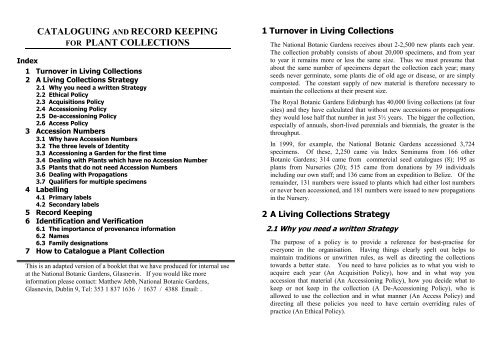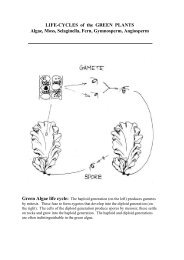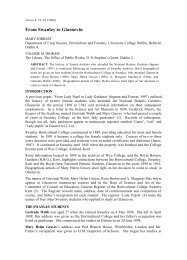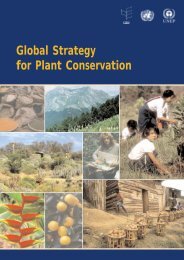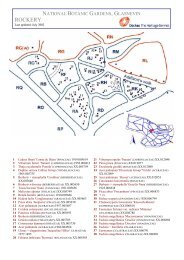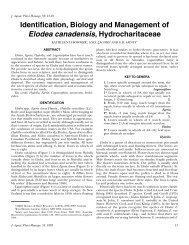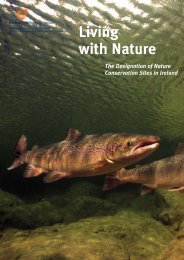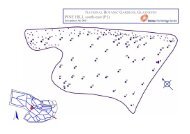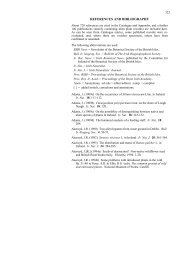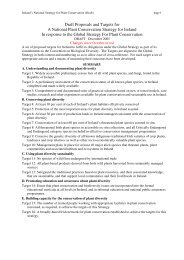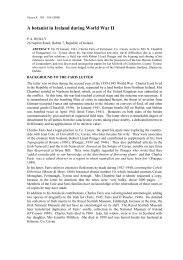Accessioning and cataloguing procedures at NBG, Glasnevin
Accessioning and cataloguing procedures at NBG, Glasnevin
Accessioning and cataloguing procedures at NBG, Glasnevin
Create successful ePaper yourself
Turn your PDF publications into a flip-book with our unique Google optimized e-Paper software.
CATALOGUING AND RECORD KEEPINGFOR PLANT COLLECTIONSIndex1 Turnover in Living Collections2 A Living Collections Str<strong>at</strong>egy2.1 Why you need a written Str<strong>at</strong>egy2.2 Ethical Policy2.3 Acquisitions Policy2.4 <strong>Accessioning</strong> Policy2.5 De-accessioning Policy2.6 Access Policy3 Accession Numbers3.1 Why have Accession Numbers3.2 The three levels of Identity3.3 <strong>Accessioning</strong> a Garden for the first time3.4 Dealing with Plants which have no Accession Number3.5 Plants th<strong>at</strong> do not need Accession Numbers3.6 Dealing with Propag<strong>at</strong>ions3.7 Qualifiers for multiple specimens4 Labelling4.1 Primary labels4.2 Secondary labels5 Record Keeping6 Identific<strong>at</strong>ion <strong>and</strong> Verific<strong>at</strong>ion6.1 The importance of provenance inform<strong>at</strong>ion6.2 Names6.3 Family design<strong>at</strong>ions7 How to C<strong>at</strong>alogue a Plant CollectionThis is an adapted version of a booklet th<strong>at</strong> we have produced for internal use<strong>at</strong> the N<strong>at</strong>ional Botanic Gardens, <strong>Glasnevin</strong>. If you would like moreinform<strong>at</strong>ion please contact: M<strong>at</strong>thew Jebb, N<strong>at</strong>ional Botanic Gardens,<strong>Glasnevin</strong>, Dublin 9, Tel: 353 1 837 1636 / 1637 / 4388 Email: .1 Turnover in Living CollectionsThe N<strong>at</strong>ional Botanic Gardens receives about 2-2,500 new plants each year.The collection probably consists of about 20,000 specimens, <strong>and</strong> from yearto year it remains more or less the same size. Thus we must presume th<strong>at</strong>about the same number of specimens depart the collection each year; manyseeds never germin<strong>at</strong>e, some plants die of old age or disease, or are simplycomposted. The constant supply of new m<strong>at</strong>erial is therefore necessary tomaintain the collections <strong>at</strong> their present size.The Royal Botanic Gardens Edinburgh has 40,000 living collections (<strong>at</strong> foursites) <strong>and</strong> they have calcul<strong>at</strong>ed th<strong>at</strong> without new accessions or propag<strong>at</strong>ionsthey would lose half th<strong>at</strong> number in just 3½ years. The bigger the collection,especially of annuals, short-lived perennials <strong>and</strong> biennials, the gre<strong>at</strong>er is thethroughput.In 1999, for example, the N<strong>at</strong>ional Botanic Gardens accessioned 3,724specimens. Of these, 2,250 came via Index Seminums from 166 otherBotanic Gardens; 314 came from commercial seed c<strong>at</strong>alogues (8); 195 asplants from Nurseries (20); 515 came from don<strong>at</strong>ions by 39 individualsincluding our own staff; <strong>and</strong> 136 came from an expedition to Belize. Of theremainder, 131 numbers were issued to plants which had either lost numbersor never been accessioned, <strong>and</strong> 181 numbers were issued to new propag<strong>at</strong>ionsin the Nursery.2 A Living Collections Str<strong>at</strong>egy2.1 Why you need a written Str<strong>at</strong>egyThe purpose of a policy is to provide a reference for best-practise foreveryone in the organis<strong>at</strong>ion. Having things clearly spelt out helps tomaintain traditions or unwritten rules, as well as directing the collectionstowards a better st<strong>at</strong>e. You need to have policies as to wh<strong>at</strong> you wish toacquire each year (An Acquisition Policy), how <strong>and</strong> in wh<strong>at</strong> way youaccession th<strong>at</strong> m<strong>at</strong>erial (An <strong>Accessioning</strong> Policy), how you decide wh<strong>at</strong> tokeep or not keep in the collection (A De-<strong>Accessioning</strong> Policy), who isallowed to use the collection <strong>and</strong> in wh<strong>at</strong> manner (An Access Policy) <strong>and</strong>directing all these policies you need to have certain overriding rules ofpractice (An Ethical Policy).
2.2 Ethical PolicyCBD <strong>and</strong> pre-CBD specimensThe N<strong>at</strong>ional Botanic Gardens has a pro-active compliance to AGENDA 21(Acting locally to preserve the environment globally), CBD (Convention onBiological Diversity - recognising th<strong>at</strong> the country of origin of a plant shouldbenefit from any intellectual, scientific, medicinal, horticultural, or financialvalue) <strong>and</strong> CITES (Convention on Intern<strong>at</strong>ional Trade in EndangeredSpecies of wild Fauna <strong>and</strong> Flora). Therefore we now have a st<strong>at</strong>ement whichthose receiving plants from the Gardens are required to sign.1. The Agreement st<strong>at</strong>es th<strong>at</strong>:! <strong>NBG</strong> <strong>Glasnevin</strong> intends to honour the letter <strong>and</strong> spirit of theConvention on Biological Diversity in the use of its collections.! Recipient may use M<strong>at</strong>erial, progeny or deriv<strong>at</strong>ives for noncommercialpurposes only.! Recipient will provide <strong>NBG</strong> <strong>Glasnevin</strong> with any benefits arising,including research results <strong>and</strong> public<strong>at</strong>ions.! <strong>NBG</strong> <strong>Glasnevin</strong> supplies m<strong>at</strong>erial on the underst<strong>and</strong>ing th<strong>at</strong> theM<strong>at</strong>erial or any progeny or deriv<strong>at</strong>ives are not commercialised,<strong>and</strong> th<strong>at</strong> if commercialised, then the recipient will enter asepar<strong>at</strong>e <strong>and</strong> negoti<strong>at</strong>ed agreement with <strong>NBG</strong>, whereby thebenefits obtained are shared fairly <strong>and</strong> equitably with the sourcecountry of the M<strong>at</strong>erial.! Recipient may not transfer M<strong>at</strong>erial without written, similaragreement2. You should try not to purchase or accept imported plants without clearunderst<strong>and</strong>ing of source <strong>and</strong> legality.! Plants bought from nurseries or dealers should be carefullyconsidered, so th<strong>at</strong> you are not supporting activities which mightbe endangering species in the wild, or supporting illegalcollecting.)! All plants coming into <strong>and</strong> out of the collections should abide byCITES regul<strong>at</strong>ions.3. Rare / Endangered species in the Collection. These need to be carefullyassessed:! Are you maximising the species survival by keeping these plants?! Wh<strong>at</strong> is their long term prospect ?! Many Irish cultivars are already extinct, how many do you keep,<strong>and</strong> how actively are they propag<strong>at</strong>ed?2.3 Acquisitions PolicyThis would be directed by the Collections Policy. It is important to have aslightly different Acquisition Policy from an <strong>Accessioning</strong> Policy, since someplants are acquired for specific displays, such as bedding plants, half-hardyannuals <strong>and</strong> the vegetables, as well as pot plants in seasonal displays (Noneof which are given Accession Numbers).Some basics for such a Policy are:1. Compliance with your Ethical Policy, CBD, CITES etc.2. A Priorities list, either of Families, Genera, Plant type or wh<strong>at</strong>ever.3. C<strong>at</strong>alogues, seed lists etc. These should be tre<strong>at</strong>ed in a system<strong>at</strong>icmanner, so th<strong>at</strong> incoming m<strong>at</strong>erial can be checked against them when itarrives.! Wild collected seed is important in such areas as shrubs or orderbed seeds, also N<strong>at</strong>ive beds should by necessity be wild-originwhenever possible. Seed from Botanic Gardens <strong>and</strong>Arboreta has a very high likelihood of being a hybrid.! Irish n<strong>at</strong>ive species should never be ordered from overseasexcept for very specific scientific needs.! Garden Origin specimens would be permitted wherehorticultural needs must be s<strong>at</strong>isfied, or where cultivars areobviously not ‘wild’ taxa.2.4 <strong>Accessioning</strong> PolicyBefore plants are Accessed you should have guidelines which ensure th<strong>at</strong> youare only accepting legitim<strong>at</strong>ely collected or acquired specimens. Nothingshould enter the Garden without first being accessed (there are a fewexceptions - see Section 3.5).1. Incoming seeds must be accessed prior to sowing.2. Multiple plants sourced from the same site or seed/propag<strong>at</strong>ion accessiononly need 1 number (some exceptions might be for known geneticdiversity in wild collected conserv<strong>at</strong>ion plants; plants collected from thewild, or old Cultivars).3. Propag<strong>at</strong>ions, cuttings etc. need new numbers when they are made (Thereare a few exceptions - see Section 3.6)
4. All separ<strong>at</strong>e plantings, pots or separ<strong>at</strong>e individuals need to have aQualifier (A,B, etc.) - see Section 3.7.5. In-transit plants going to other gardens or displays. Because th<strong>at</strong> gives arecord of such movements through the garden.2.5 De-accessioning PolicyFor the same reason you have guidelines for accessioning, you should alsohave guidelines for de-accessioning. No plant should be removed from thegarden without obtaining certain pieces of inform<strong>at</strong>ion:! Do you know exactly wh<strong>at</strong> it is ?! Do you have other specimens ?! Could you obtain it again easily ?! Should you <strong>at</strong>tempt to keep it in the form of cuttings or seed ?! Is it covered by a CBD agreement ?! Is it in accordance with your Ethical Policy ?! Could you transfer it to another Garden ?! To the compost heap ?! Will it be beneficial to the collection as a whole ?A dynamic procedure needs to be implemented to bring about mixed-agest<strong>and</strong>s of tree collections, such as Oaks, Ash, Beech, Maples etc. Should youactively remove old / decrepit, low value collections, such as trees past theirprime ?, or of little aesthetic value, poor provenance ? etc.2.6 Access PolicyAccess to the collections for propag<strong>at</strong>ion purposes by outsiders needs to becarefully regul<strong>at</strong>ed. Access must conform to CITES/CBD etc. You mayotherwise fall foul of other Botanic Garden's policies if you have no firmcommitments.Simply keeping a record of wh<strong>at</strong> goes to whom, <strong>and</strong> getting recipients to signthe st<strong>at</strong>ement in your Ethical Policy (Section 2.2) is sufficient to demonstr<strong>at</strong>ecompliance with CBD. A st<strong>and</strong>ard formal letter should be put in place.3 Accession Numbers3.1 Why have Accession Numbers.An Accession Number serves the purpose of <strong>at</strong>taching the document<strong>at</strong>ion ofa plant (Its source, the d<strong>at</strong>e it arrived, whether you have propag<strong>at</strong>ed from it,wh<strong>at</strong> it was previously called, has it been critically determined etc.) to theactual specimen. If this link is broken it may be possible to re-establish it if,for example, you know you have only a single or limited number ofspecimens of the given species or cultivar, <strong>and</strong> can exclude otherpossibilities, or you have the specimen mapped accur<strong>at</strong>ely.1. Each Accession Number identifies one or a group of plants th<strong>at</strong>:! are of the same taxon! are of the same propagule type (or tre<strong>at</strong>ment)! were received from the same source! were received <strong>at</strong> the same time.2. Accession Numbers can never be re-used, transferred or assumed (it isbetter to scrap an uncertain one <strong>and</strong> Re-accession - see Section 3.6)3. Some plants already in the collection might need to be Re-accessionedfor one of the following reasons! Where it is discovered the original b<strong>at</strong>ch of plants was mixed, or oneplant shows extreme vari<strong>at</strong>ion.! Where the original number is lost or unknown (this includes some forwhich numbers were never issued). If the original number isdiscovered l<strong>at</strong>er on, then the history (<strong>at</strong>tached to th<strong>at</strong> number) can berestored to the plant. The new number is thus acting as a Tracenumber (see 3.4), storing inform<strong>at</strong>ion in the meantime until it can beunambiguously associ<strong>at</strong>ed with its original number.4. Whenever a propag<strong>at</strong>ion, division, grafting or some other multiplic<strong>at</strong>ionof a plant (i.e. a seed or cutting of a shrub, climber or tree) isundertaken, then a new Accession Number must be issued to thepropag<strong>at</strong>ions, except for certain limited conditions, namely:! Where the propag<strong>at</strong>ion is equal <strong>and</strong> clonal (i.e. division of a hardyherbaceous Perennial).! Where tender perennials (Penstemon etc.) or potted plants(Pelargonium) are being bulked up for display.! Where annual seed is re-sown.It is important th<strong>at</strong> Accession Numbers are issued before a seed germin<strong>at</strong>es, acutting strikes or a grafting takes. This provides a record of propag<strong>at</strong>ion<strong>procedures</strong>. This will provide you with much useful inform<strong>at</strong>ion in the future.Eventually the d<strong>at</strong>abase will tell you:• whether a particular mother plant produces better cuttings,
four <strong>and</strong> six-decimal place codes will not look odd if you use a 2-charactercode, since the numbers all end up as being 8 digits long, <strong>and</strong> if <strong>and</strong> whenthey do acquire a year of accession, this still carries the additionalinform<strong>at</strong>ion th<strong>at</strong> the number was originally an XXnumber, <strong>and</strong> it is not thecase th<strong>at</strong> <strong>at</strong> least 9,464 plants arrived in the gardens in 1963, for example.Zeros are very important <strong>and</strong> must not be left out, nor must the year beshortened. Do not use a backslash (use a fullstop only) <strong>and</strong> do not run thenumbers together (19990012). Carefully plan a system <strong>and</strong> write down abasic set of rules so th<strong>at</strong> all the staff underst<strong>and</strong> wh<strong>at</strong> is happening.3.4 Dealing with plants which have no Accession NumberPlants loose their labels, sometimes through pruning, sometimes throughbeing stolen or falling off, <strong>and</strong> sometimes because it has become illegible orwrongly copied There are several ways of recovering numbers.1. Another member of staff may know something about where, or when theplant was moved to its current position. With a year, or an internalloc<strong>at</strong>ion, it may be possible to find a number, or determine whether it wasever accessioned in the first place.2. There is the possibility th<strong>at</strong> the plant is listed or mapped.3. The plant may be unique enough to make it worthwhile checking theaccessions books - both ledger <strong>and</strong> electronic versions.If all these methods fail then the best thing is to issue the plant with a TraceNumber. This is simply a new number for the current year, which can beused in the meantime, in the hope th<strong>at</strong> one day the correct (if it ever existed)Accession Number may be found, <strong>and</strong> can be 're-<strong>at</strong>tached' to the specimen.In this way you will be able to continue recording the history of a plant.Any bed or section of border th<strong>at</strong> is being re-planted should be fully listed<strong>and</strong> any unnumbered plants can either be hunted down in the c<strong>at</strong>alogues <strong>and</strong>,if unfound, then issued with a Trace Number. With herbaceous plants, asequential number for the current year is issued. With woody shrubs,climbers or trees, it is not a good idea to go on issuing 2000 or 2001numbers, so an XXnumber is used, since these plants have a real sizerel<strong>at</strong>ive to their age.3.5 Plants th<strong>at</strong> do not need Accession NumbersThere are a few exceptions to the rule th<strong>at</strong> "All plants entering the gardenrequire an Accession Number". For example the following plants are notaccessioned <strong>at</strong> the N<strong>at</strong>ional Botanic Gardens, <strong>Glasnevin</strong>:! Annuals such as the Half-Hardy display, Sweet Peas, <strong>and</strong>Vegetables, but not those in the Family <strong>and</strong> N<strong>at</strong>ive beds etc.! Biennials <strong>and</strong> Perennials th<strong>at</strong> are tre<strong>at</strong>ed as bedding plants, i.e.they are bought in <strong>and</strong> turned out <strong>at</strong> the end of the year (this includesTulips, Daffodils etc.)3.6 Dealing with Propag<strong>at</strong>ionsHistorically when a propag<strong>at</strong>ion was undertaken in the N<strong>at</strong>ional BotanicGardens, the original Accession Number was used. To all intents <strong>and</strong>purposes this is still quite useful, however, the following plants were allpropag<strong>at</strong>ed in 1998, they are all only 2 years old, but would have carriedthese numbers for the rest of their lives.1886.009462 Ilex aquifolium 'Smithiana'1926.004182 Salix fargesii1962.009425 Ilex × altaclerensis 'Hodginsii'By issuing new numbers we have a permanent record of when <strong>and</strong> how apropag<strong>at</strong>ion is made. In the case of a woody shrub or tree it also gives anaccur<strong>at</strong>e measure of the age of the plant. In issuing a new number, the oldnumber is used as the source of the m<strong>at</strong>erial, <strong>and</strong> becomes a Lineagenumber.Different methods of propag<strong>at</strong>ion have different outcomes, especially withregard to the genetic make-up of a plant. For example it might be clonal (acutting, layering, or division), a graft, or seed may have been sown. Whenusing seed or ordering seed from other Botanic Gardens you must be awareof the potential consequences. The majority of Sorbus <strong>and</strong> Malus seeds forexample are nearly always outcrossed (being self-sterile), so all seeds will behybrids unless several individuals of the same species are st<strong>and</strong>ing together,<strong>and</strong> isol<strong>at</strong>ed from others. Altern<strong>at</strong>ively some species such as Sorbushupehensis, S.forrestii <strong>and</strong> S.vilmorinii are all apomictic (seeds are setautom<strong>at</strong>ically without pollin<strong>at</strong>ion), <strong>and</strong> come absolutely true from seed, theseare therefore perfect clones of the mother tree.
With zonal Pelargoniums <strong>and</strong> Penstemons you still need to know wheresomething originally came from, so they are issued with Accession Numberswhen they first arrive. Each year fresh cuttings are made, however, <strong>and</strong> theprevious plants will usually be thrown out. In these cases you continue totransfer the Accession Numbers from plants of previous years to the freshplants. A list of these 'exempted' propag<strong>at</strong>ions needs to be established.3.7 Qualifiers for multiple specimensWhen a seed b<strong>at</strong>ch or propag<strong>at</strong>ion fails to germin<strong>at</strong>e or strike, then the singlenursery label is returned to the records office, <strong>and</strong> the d<strong>at</strong>abase can beupd<strong>at</strong>ed to record its failure. If a plant has successfully established itself,however, it may be th<strong>at</strong> there are anything from one to dozens of individualspecimens.If one or more plants are moved into the Gardens (into one or moreloc<strong>at</strong>ions), while some are retained in the Nursery then there may beproblems in knowing whether an entire Accession Number is alive or dead inthe collections. If the single, original label stays behind in the Nursery withliving plants which then die, then there is a risk th<strong>at</strong> the label will be sent tothe records office under the misapprehension th<strong>at</strong> the accession is dead, whenin fact an individual is still alive on the grounds somewhere. Likewise ashrub dying, or being stolen, on the grounds could be recorded in the 'Dead'book, but is in fact still alive in the nursery, or in another loc<strong>at</strong>ion within theGarden.For these reasons a propag<strong>at</strong>ion (whether incoming seed or an internallysourcedcutting etc.) only ever gets a single label. If two identical labelswere issued, then an apparent ‘complete’ de<strong>at</strong>h might be erroneouslyrecorded. If it is necessary to label several pots then a distinctive 'Duplic<strong>at</strong>eLabel' should be used:Chelsea2142000.0912 PLUMBAGINACEAELimonium emargin<strong>at</strong>umMultiple specimens need to be given qualifiers. A qualifier is a letter afterthe accession number, which tells you where an individual, or group ofindividuals, is in the Gardens.Example 1:Twenty four plants of Primula farinosa germin<strong>at</strong>e from AccessionNumber 1999.2334. Ten plants are planted in the rockery <strong>and</strong> theremaining 14 are retained as display plants for the Alpine house.These would be numbered as follows:1999.2334A 14 plants in NU1999.2334B 10 plants in RGSome months l<strong>at</strong>er, six plants in the nursery are planted into a troughin the Alpine yard. The records are upd<strong>at</strong>ed as:1999.2334A 8 plants in NU1999.2334C 6 plants in AYA year l<strong>at</strong>er the plants in the trough produce seed which is saved <strong>and</strong>placed in cold storage in case the plant should be lost in the future.The seed would be recorded as 1999.2334C indic<strong>at</strong>ing which plant(s)it came from. If it is then sown in 2004, it will be issued a2004.____ Accession Number, <strong>and</strong> 1999.2334C becomes theLineage number for th<strong>at</strong> accession..Example 2: A quantity of Ranunculus alpestris seed is accessioned as 1999.2335.Some of the seed was sown <strong>and</strong> the remainder was sent to the coldstore where it was stored as 1999.2335B. The seed th<strong>at</strong> was sowneventually produced 6 plants. Two were planted in the Family beds,the remainder were kept in the Nursery for displaying in the alpinehouse. The records would be as follows:1999.2335A seed in store1999.2335B 2 plants in F11999.2335C 4 plants in NUIf seed had been collected from a number of specimens (i.e. B & C)<strong>and</strong> pooled then th<strong>at</strong> would be stored using the next availablequalifier:1999.2335D seed in storeIf the Family bed plants both died, they might be replaced with oneother from the Nursery plants, <strong>and</strong> the records upd<strong>at</strong>ed as:1999.2335C 3 plants in NU1999.2335E 1 plant in F1ChelseaDUPL 2000.0912 PLUMBAGINACEAELimonium emargin<strong>at</strong>umExample 3:Laburnum alpinum was accessioned as 1999.2329. 4 plantsgermin<strong>at</strong>ed. One was planted in the Legume class area, <strong>and</strong> after anumber of years the remaining plants in the nursery were sent to otherDúchas gardens. The records then would read:
4 Labelling1999.2329A de-accessioned1999.2329B 1 plant in LELabels are the key to linking the inform<strong>at</strong>ion held in the records to the actualspecimen. There are several levels of labelling. A Primary label (orNursery label) is the label a cutting or sown seed is marked with, often asowing d<strong>at</strong>e is added. When ready for public display a Secondary label isproduced which may show inform<strong>at</strong>ion useful to the General public, such asa common name, the n<strong>at</strong>ural distribution of the plant, its source etc. ATertiary label is a back-up label - it might be an aluminium XXnumber disc,or the original primary label pushed down inside the pot or buried below theplant.4.1 Primary LabelsWhen a seed is sown, a label is printed out in the herbarium <strong>and</strong> fixed to aspike label. Only one of these labels should ever be issued, so th<strong>at</strong> if theplant fails, this label can be returned to the records office <strong>and</strong> tre<strong>at</strong>ed as a'dead' plant. A Primary label acts as a paper-trail for knowing wh<strong>at</strong> plantssurvive the vital first step (germin<strong>at</strong>ion, rooting etc.). Because of this, theymust never be peeled off, <strong>and</strong> must never exist in more than a single copy.Some examples of Primary Labels:8/1/00AGS219This is a Primula seed packet from the Alpine Garden Society, number 219 intheir 1999 c<strong>at</strong>alogue. It arrived on the 17 th January <strong>at</strong> <strong>Glasnevin</strong>, <strong>and</strong> wasAccessed as 2000.0169.<strong>NBG</strong>Prop2000.0169 PRIMULACEAEPrimula minima1999.3341 1995.0258 ERICACEAECalluna vulgaris ‘County Wicklow’This is a cutting made on the 3 rd November 1999, when the Millfield bedswere replanted. The original Accession Number th<strong>at</strong> the plant arrived in theGarden under is 1995.0258, this is its Lineage number. Checking theaccessions book reveals th<strong>at</strong> the plant arrived from Doran's nurseries, Naas,on the 7 th June 1995.4.2 Secondary LabelsSecondary Labels are the labels th<strong>at</strong> are <strong>at</strong>tached to plants for the generalpublic to read. It is important th<strong>at</strong> labels within the gardens are uniform in theinform<strong>at</strong>ion they carry <strong>and</strong> in the way it is laid out.One particularly important change since 1995 is th<strong>at</strong> cv. should no longer beused to indic<strong>at</strong>ed a cultivar. Instead the cultivar name should be enclosed insingle inverted commas (‘…’) or straight quotes ('…').The following rules apply to all new secondary labels <strong>at</strong> <strong>Glasnevin</strong>:# All new labels must have an Accession Number.# XXnumbers (including those with years) must have 6 decimal places.# Sequential numbers must have 4 decimal places only.# Accession numbers for 2000.0000 specimens must have a qualifier(A,B, etc.) if there is more than one loc<strong>at</strong>ion for the accession.# The species name must all be written in an identical font size (notsmaller).# The cultivar name (if there is one) must be placed in quotes <strong>and</strong>written in lower case, with the initial letter(s) in capitals. Never withthe abbrevi<strong>at</strong>ion cv.A st<strong>and</strong>ard label looks like this:SOURCEACCESSION NUMBERFAMILYSpecies nameSUBSP. VAR. or ‘Cultivar’Common NameCOUNTRY OF ORIGINThe Source, <strong>and</strong> whether or not the plant has been verified (V), are notoblig<strong>at</strong>ory <strong>and</strong> should be regarded as a m<strong>at</strong>ter of judgement. Suchv
inform<strong>at</strong>ion is on record somewhere else <strong>and</strong> is not necessarily of interest orconsequence to most visitors. The Country of Origin on the other h<strong>and</strong> isinform<strong>at</strong>ion which can be useful to members of the public.The Family should be written in small capitals (N.B. LILIACEAE seeSection 6.3), the species (+subspecies, variety) name in large capitals,cultivar <strong>and</strong> common names in lower case with leading capitals. Differentsized labels are permitted, but the same six rules must apply.5 Record KeepingAs plants are moved <strong>and</strong> transferred to permanent loc<strong>at</strong>ions, the records needto be upd<strong>at</strong>ed. In doing so, lists are prepared for ordering of SecondaryLabels.INITIAL PLANTING OUTA st<strong>and</strong>ard form should be filled in for the initial move from the Nursery toplanting out loc<strong>at</strong>ions. At this point it is important to know whether theentire accession or only a part is moved. If the accession is divided into morethan one loc<strong>at</strong>ion (i.e. one or more specimens stay in the nursery) then aqualifier is needed (see Section 3.7).MOVING / RE-MOVING PLANTSLikewise moving some or all plants from one loc<strong>at</strong>ion to another requires th<strong>at</strong>the same form be filled in, sometimes to merely change the loc<strong>at</strong>ioninform<strong>at</strong>ion, sometimes to increase the number of qualifiers. A Dead bookneeds to be maintained. Each section or gardener should have a Dead book,where records of plants th<strong>at</strong> have died can be noted. These records can beupd<strong>at</strong>ed to the computer <strong>at</strong> regular intervals.6 Identific<strong>at</strong>ion <strong>and</strong> Verific<strong>at</strong>ion6.1 The importance of provenance inform<strong>at</strong>ionWithout the source of a plant, it can sometimes prove difficult, if notimpossible, to name the specimen correctly. Seed sourced from otherBotanic Gardens or Arboreta has usually come from collections where manyspecies, varieties <strong>and</strong> cultivars of the same genus are growing cheek-by-jowl.The result is a high risk, if not certainty in many cases, of hybridis<strong>at</strong>ion.Example:White-barked Birches are notorious for hybridising. On the Birchclass lawn <strong>at</strong> <strong>NBG</strong> there are seven Birch trees, each <strong>at</strong> least 30 yearsold, with the label ‘Betula sp.’ In all cases, where the provenance isknown, these trees have come from Arboreta or other BotanicGardens. These trees cannot be s<strong>at</strong>isfactorily identified, <strong>and</strong> areprobably all of hybrid origin.As mentioned under Section 3.6, some plants, such as Sorbus <strong>and</strong> Malus arewh<strong>at</strong> are known as oblig<strong>at</strong>e outcrossers, i.e. they cannot self-pollin<strong>at</strong>ethemselves <strong>and</strong> can only set seed when pollen from another plant l<strong>and</strong>s on thestigma. Thus for the majority of species in these genera, all seeds will behybrids unless several individuals of the same species are st<strong>and</strong>ing together,<strong>and</strong> isol<strong>at</strong>ed from others. Altern<strong>at</strong>ively some species, such as Sorbusforrestii, S. hupehensis. <strong>and</strong> S.vilmorinii are all apomictic (seeds are setautom<strong>at</strong>ically without pollin<strong>at</strong>ion), <strong>and</strong> come absolutely true from seed, theseare therefore perfect clones of the mother tree. Thus obtaining these plantsfrom virtually any source would be fine, since it is the very same clone th<strong>at</strong>was originally collected by Forrest (or whoever) in China.Thus, where woody m<strong>at</strong>erial of species, or n<strong>at</strong>urally occurring varieties, isbeing sourced it is important to obtain the seed from either a wild source, orfrom propag<strong>at</strong>ions of known, certified wild origin m<strong>at</strong>erial. There is no pointin planting a tree with an estim<strong>at</strong>ed life span of 50-100 years if it might notbe possible to <strong>at</strong>tach a name to it l<strong>at</strong>er. It is therefore always better to throwaway or remove suspect m<strong>at</strong>erial in favour of the genuine article. Wherehorticultural needs, aesthetics or simply ‘interesting’ m<strong>at</strong>erial is <strong>at</strong> h<strong>and</strong>, thenyou would take the pragm<strong>at</strong>ic view th<strong>at</strong> it is worth hanging on to such plants.6.2 NamesChecking on the correct name of a species or cultivar is not alwaysstraightforward, <strong>and</strong> nor are all books correct! For example, Bean's Trees &Shrubs has useful inform<strong>at</strong>ion on origins, cultiv<strong>at</strong>ion <strong>and</strong> biology, but thenames are often out of d<strong>at</strong>e, <strong>and</strong> the usage of cv. followed by the cultivarname in inverted commas is quite wrong. The RHS Dictionary (4 volumeorange set) has many errors, although the usage of names is usually correct.The Plant Finder is an excellent guide to the more usual cultivars <strong>and</strong> theircorrect spelling <strong>and</strong> design<strong>at</strong>ion. Kew Index is only a listing of publishedplant names, <strong>and</strong> does not tell you wh<strong>at</strong> the currently accepted name is. TheEuropean Garden Flora is a useful book for identifying Garden plantspecies or subspecies, but has no inform<strong>at</strong>ion on cultivars.
The fe<strong>at</strong>ures to check are 1. whether the plant conforms to the description, 2.Whether the present name is regarded as a synonym or invalid, <strong>and</strong> lastly 3.Whether any sub-specific c<strong>at</strong>egory, if there is one, is a subspecies, a varietyor a cultivar name.Since 1995 it has become m<strong>and</strong><strong>at</strong>ory to use inverted commas for design<strong>at</strong>ingcultivar names, <strong>and</strong> the use of cv. is discouraged. All new labels shouldconform to this usage.6.3 Family design<strong>at</strong>ionsThe N<strong>at</strong>ional Botanic Gardens decided, some years ago, to drop thetraditional names for eight families, <strong>and</strong> to adopt the st<strong>and</strong>ardised names.Thus the following names are used on our labels:Traditional Name <strong>NBG</strong> usageCompositae Asteraceae Daisy FamilyCruciferae Brassicaceae Cabbage FamilyGramineae Poaceae Grass FamilyGuttiferae Clusiaceae St.John’s wort FamilyLabi<strong>at</strong>ae Lamiaceae Mint FamilyLeguminosae Fabaceae Pea FamilyPalmae Arecaceae Palm FamilyUmbelliferae Apiaceae Carrot FamilyOther family divisions sometimes change. For example the familyEscalloniaceae is sometimes regarded as part of Grossulariaceae, which inturn is seen by some authorities as part of Saxifragaceae. Other examples ingardens are: Nolanaceae which is now part of Solanaceae; Francoaceaewhich is part of Saxifragaceae. Some genera are shifted from one family toanother. Thus the New Zeal<strong>and</strong> shrub Corokia has long been placed in theCornaceae, but the DNA evidence now gives added weight to the argumentth<strong>at</strong> it is in fact a member of the family Grossulariaceae.Consistency is important, <strong>and</strong> <strong>at</strong> the N<strong>at</strong>ional Botanic Gardens, <strong>Glasnevin</strong> wefollow the arrangement in Brummitt (but note th<strong>at</strong> the traditional familynames are used there), which is more or less wh<strong>at</strong> the RHS Plant Finder nowfollows. A list of the more common problem genera are:CorokiaEscalloniaGROSSULARIACEAEESCALLONIACEAEAGriseliniaHypericumIteaOrobancheGRISELINACEAECLUSIACEAEESCALLONIACEAEASCROPHULARIACEAELILIACEAE was once a c<strong>at</strong>ch-all family, with 4,500 species in nearly 300genera. Today the family is sometimes split into 22 separ<strong>at</strong>e families, suchas Alliaceae, Hyacinthaceae, Convallariaceae, Hostaceae etc. You need todecide whether your garden will adopt the broader concept or the narrowerconcept. The authority for these th<strong>at</strong> we follow <strong>at</strong> <strong>NBG</strong> is Brummitt’sVascular plant families <strong>and</strong> genera <strong>and</strong> the RHS Plant Finder, whichrecognise the 22 narrower concepts. Examples of genera <strong>and</strong> their families:Agapanthus (Alliaceae), Agave (Agavaceae), Albuca (Hyacinthaceae), Allium (Alliaceae), Aloe(Aloaceae), Alstoemeria (Alstroemeriaceae), Asparagus (Asparagaceae), Asphodeline(Asphodelaceae), Asphodelus (Asphodelaceae), Astelia (Asteliaceae), Bomarea(Alstroemeriaceae), Brodiae (Themidaceae), Cardocrinum (Liliaceae), Chionodoxa(Hyacinthaceae), Colchicum (Colchicaceae), Convallaria (Convallariaceae), Cordyline(Agavaceae), Crinum (Amaryllidaceae), Dasylirion (Dracaenaceae), Dracaena (Dracaenaceae),Eremurus (Asphodelaceae), Erythronium (Liliaceae), Eucomis (Hyacinthaceae), Fritillaria(Liliaceae), Gagea (Liliaceae), Galanthus (Amaryllidaceae), Gasteria (Aloaceae), Haworthia(Aloaceae), Hemerocallis (Hemerocallidaceae), Hippeastrum (Amaryllidaceae), Hosta(Hostaceae), Hyacinthoides (Hyacinthaceae), Hyacinthus (Hyacinthaceae), Kniphofia(Asphodelaceae), Lilium (Liliaceae), Liriope (Convallariaceae), Muscari (Hyacinthaceae),Narcissus (Amaryllidaceae), Nolina (Dracaenaceae), Ophiopogon (Convallariaceae), Paris(Trilliaceae), Polygon<strong>at</strong>um (Convallariaceae), Ruscus (Ruscaceae), Sansevieria(Dracaenaceae), Scilla (Hyacinthaceae), Trillium (Trilliaceae), Tritelia (Themidaceae),Tulbaghia (Alliaceae), Tulipa (Liliaceae), Ver<strong>at</strong>rum (Melanthiaceae), Yucca (Agavaceae).CLADISTICSThere are other changes afoot th<strong>at</strong> you need to be aware of. For example,study of the evolutionary history of the family Sapindaceae reveals th<strong>at</strong> closerel<strong>at</strong>ives of both the maples <strong>and</strong> horse-chesnuts lie within the large tropicalfamily Sapindaceae (in the mid-19 th Century these families were combined inthis manner). A similar case is th<strong>at</strong> for Taxodiaceae/CupressaceaeAraliaceae/Apiaceae Apocynaceae/Asclepiadaceae. Thus in certain modernevolutionary texts these families are united. In effect, Taxodiaceae is theancient group which is gradually becoming extinct, whilst Cupressaceae is amodern deriv<strong>at</strong>ive which is still evolving from within this ancient family. At<strong>Glasnevin</strong> we continue to use Hippocastanaceae <strong>and</strong> Aceraceae, as well asTaxodiaceae <strong>and</strong> Cupressaceae <strong>and</strong> the other families for the time being.
7. How to C<strong>at</strong>alogue a Plant CollectionThe first decision is how to store your d<strong>at</strong>a. Obviously it is likely you willwant some sort of electronic system. Some programs are expensive(BGBASE) while others are virtually st<strong>and</strong>ard on many new computers(Wordprocessors, Spreadsheets, ACCESS etc.). The first questions youshould ask yourselves are:1. Will all the staff be able to use it easily? This is VERY important if youwant to make sure you have a functional system.2. Plan how you are going to deal with the backlog of plants which have noaccession number. Devise an infallible system to ensure numbers are notgiven out twice to this backlog. Pre-numbered stainless steel tags is agood method (ca. UK£130 / 1,000 from Stobart-Davies Ltd, PrioryHouse, Priory Street, Hertford, SG14 1 RN; 01992 501 518, fax .. 519).3. Wh<strong>at</strong> sort of output do you want?◦ Plant lists for particular lawns or borders.◦ To know where plants came from.◦ Wh<strong>at</strong> has been propag<strong>at</strong>ed / wh<strong>at</strong> have you yet to propag<strong>at</strong>e.◦ To list all members of a particular plant family◦ A list of all climbers or treesD<strong>at</strong>abasesBG-Base is the ultim<strong>at</strong>e Botanic Gardens d<strong>at</strong>abase system, but veryexpensive <strong>and</strong> not popular amongst staff of mixed computer abilities. BG-RECORDER is an Access-based program designed for being cheaper <strong>and</strong>easier to use. It is produced by Botanic Gardens Conserv<strong>at</strong>ion Intern<strong>at</strong>ional,Descanso House, 199 Kew Road, Richmond Surrey, TW9 3BW U.K. Email:bgci@rbgkew.org.uk www.bgci.org.uk. It costs ca. £50. It does require afamiliarity with Access, <strong>and</strong> may not be logical to non-computer folk. Lastlyyou could write your own Access system, which some gardens have done, butthis can be very time-consuming <strong>and</strong> make the system inaccessible orincomprehensible to others in your organis<strong>at</strong>ion. Spreadsheet programs onthe other h<strong>and</strong> are very user-friendly, <strong>and</strong> for collections of a few thous<strong>and</strong>specimens, where you want to encourage all staff to particip<strong>at</strong>e in a c<strong>at</strong>alogue(the only way to really make it work) I would strongly recommend them.Before describing the advantages please be aware of the disadvantages:1. Inform<strong>at</strong>ion is repe<strong>at</strong>ed, thus every Rose cultivar <strong>and</strong> species has torecord the fact th<strong>at</strong> it is in the genus Rosa <strong>and</strong> the family Rosaceae. Ifyou make a spelling mistake i.e. Srobus, then a list of Sorbus might missthis r<strong>at</strong>her important fact – in a d<strong>at</strong>abase the genus name is, in theory,recorded just once.2. Complic<strong>at</strong>ed outputs or enquiries are not possible without a lot ofediting (i.e. a list of all Rosaceae you have received from NorthAmerican Nurseries; a list of Shrubs th<strong>at</strong> you have taken propag<strong>at</strong>ionsfrom in the past 2 years etc.) This kind of d<strong>at</strong>a h<strong>and</strong>ling requires ad<strong>at</strong>abase program.A Spreadsheet c<strong>at</strong>alogueThere are three vital pieces of inform<strong>at</strong>ion you need to know for each plant inyour collection:1. Wh<strong>at</strong> is its provenance (Where <strong>and</strong> who did it come from)2. Where is it growing (Its current loc<strong>at</strong>ion in the collection)3. Wh<strong>at</strong> is its nameIn addition it can be useful to know the following facts:4. Wh<strong>at</strong> is its history (did it loose a limb in a particular gale; when did itfirst bear fruit etc.)5. Did it get re-identified after growing for a number of years? wh<strong>at</strong>was it called before?6. Has it been propag<strong>at</strong>ed, <strong>and</strong> where did these offspring end up?I order to equ<strong>at</strong>e this written inform<strong>at</strong>ion to the individual plant, it is best touse a code number, or Accession Number th<strong>at</strong> will uniquely identify it. Thisnumber must not be reused if it dies or is removed. It is best to incorpor<strong>at</strong>ethe year of acquisition (2000.0001, 2000.0002 etc.) because it then gives theage of the tree. Where a year of planting is unknown then I would suggestusing an unknown year code such as XXXX.0001. Numbers should not bewritten without leading zeros, because 2000.1 can be misread as 2000.1000.If you get more than one individual seedling or sapling, but they have allcome from the same source <strong>and</strong> are more or less the same, then one accessionnumber is used, but with a qualifier (2000.0001A, 2000.0001B, C..etc.). Thenumber records the origin (which is the same for all), but the individual planthas its own history <strong>and</strong> is a unique individual.A spreadsheet program such as Excel will be adequ<strong>at</strong>e for storinginform<strong>at</strong>ion. Attached are some examples of our d<strong>at</strong>a laid out in spreadsheet
form<strong>at</strong>. The 1998 sheet shows wh<strong>at</strong> our own propag<strong>at</strong>ion d<strong>at</strong>a looks like.The minimal d<strong>at</strong>a we keep is:DATE D<strong>at</strong>e the plant arrived or the inform<strong>at</strong>ion was recorded.SOURCE Who we received the plant from, with the full address if itis not one of our regular sources.SOURCE Acc Numb If it is a propag<strong>at</strong>ion from within your ownGarden, then the accession number (<strong>and</strong> qualifier) of theoriginal plant is put here. If you re-use accession numbersfor cuttings or seedlings, then a 3 year old cutting from a40 year old shrub might have the number 1961.0123which gives a false idea of its actual age. Whilst1997.1085 will have the inform<strong>at</strong>ion about when thecutting was taken, how it was tre<strong>at</strong>ed, <strong>and</strong> who the motherplant was (1961.0123).ACC NO This is a simple series of 4 digit year <strong>and</strong> 4 digit number.These numbers should never be re-issued.QUALFIER This is a letter. If we have more than one individual plantth<strong>at</strong> has come from the same source but is growing in adifferent loc<strong>at</strong>ion we can distinguish them with thequalifier. With a mass planting (say of herbaceous plants)there is no need for a qualifier if they are all in the sameloc<strong>at</strong>ion. Qualifiers help to distinguish an individual of agroup of otherwise identical individuals.NAME Botanical name of the plant.VERN Vernacular name for the species or cultivar.AUTHOR Author of the name.REF Any code number the nursery c<strong>at</strong>alogue or collector used -useful for checking back in the future.SRC An abbrevi<strong>at</strong>ion we use on the labels.FAMILY Botanical family, useful if you want to produce a list ofall the Rosaceae in your collection.TYPESECTIONHow it arrived: s=seed, c=cutting, p=plant etc.Where it is growing - we divide the Botanic gardens into178 different lawns or shrubberies. You might want tohave a secondary number for its position on a lawn orwithin a border or shrubbery.PROVENANCE Where the original seed or sapling came from.VERIFICATION Wh<strong>at</strong> it has been called in the past, <strong>and</strong> who currentlynamed the plant or wh<strong>at</strong> book was used to check thename/identify the plant. Maybe a book illustr<strong>at</strong>ion th<strong>at</strong>helped you identify the plant.HISTORY Any relevant inform<strong>at</strong>ion about the plant's history,damage, fertiliser use, pests, diseases, how it died,whether you passed on seed or cuttings to other growers.DEAD/LIVINGDEADWZGPlant TypeIs the plant alive (L) or Dead (D).How <strong>and</strong> when the plant died - this is very useful inknowing wh<strong>at</strong> mistakes not to make in the future, or wh<strong>at</strong>precautions to take. This is why it is best to alwaysnumber seed before you sow or cuttings before theystrike. If it doesn't germin<strong>at</strong>e/root it is useful to know soas to try a different procedure next time. Dead plantsshould never be deleted from a c<strong>at</strong>alogue – it is veryuseful to know where it was once grown <strong>and</strong> when <strong>and</strong>why it died.This can be important when trying to identify the plant, orwhere the species is of conserv<strong>at</strong>ion importance.W=Known wild origin; G= Garden origin; Z=seedling orcutting from a plant of known wild origin. Where acultivar is being grown it is useful to know if it came fromthe original clone or not. For example Rosemary Browngrew the first Helleborus ‘Graigueconna’, <strong>and</strong> thereforethis specimen is from the true mother plant <strong>and</strong> is markedC=Clonal.If you want to list trees, herbaceous plants, climbers,tender plants etc. or spring-flowerers or plants by flowercolour,then you must add a ‘Plant type’ c<strong>at</strong>egory, orc<strong>at</strong>egories, <strong>and</strong> devise a coding system. Th<strong>at</strong> way you canoutput a list of all the living January/February floweringvines for example.


